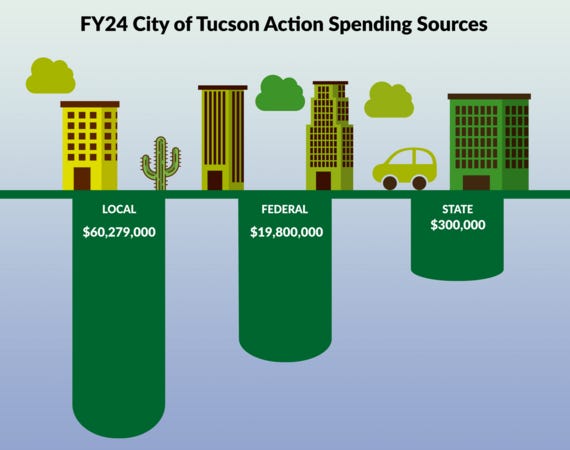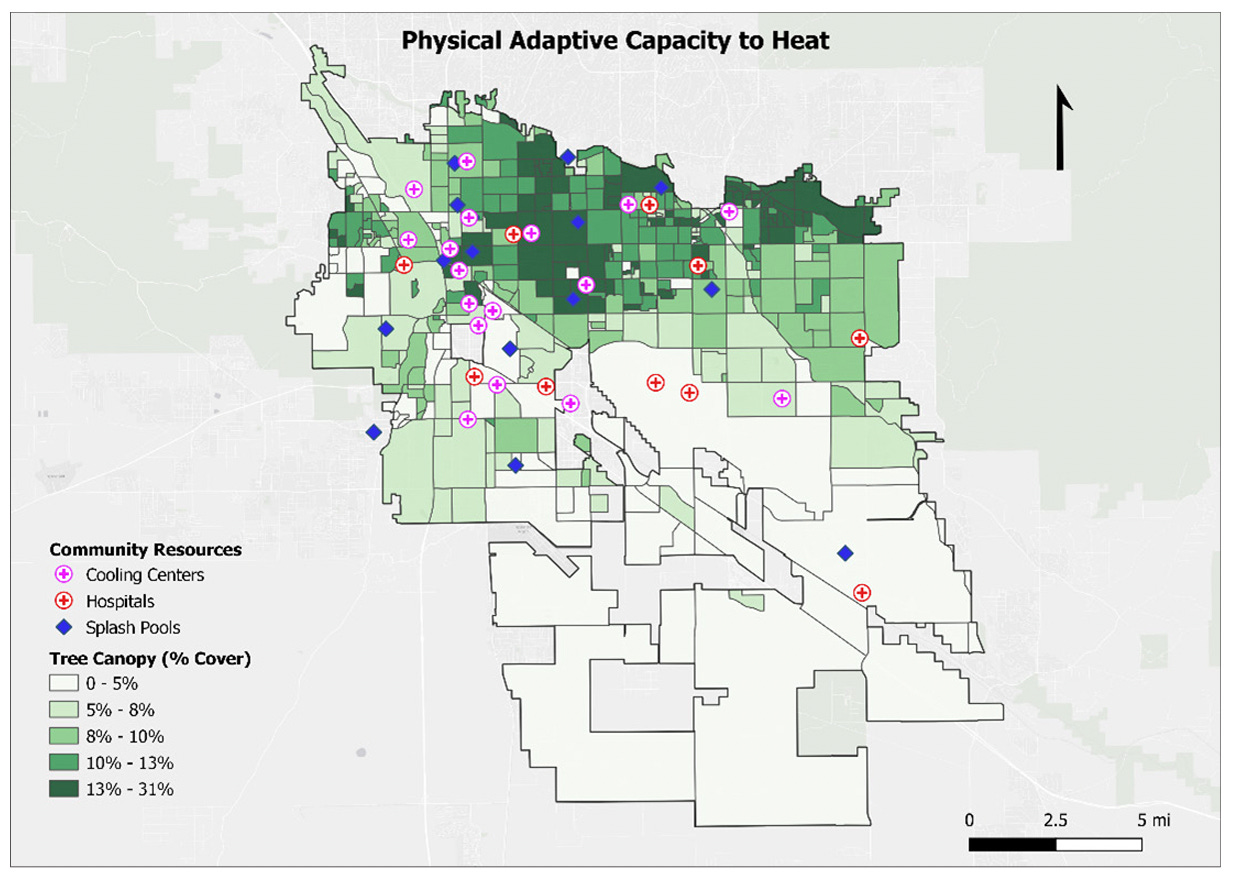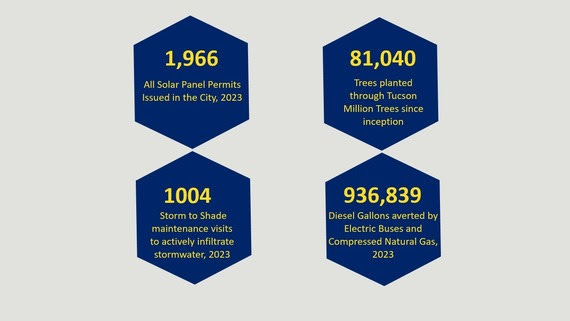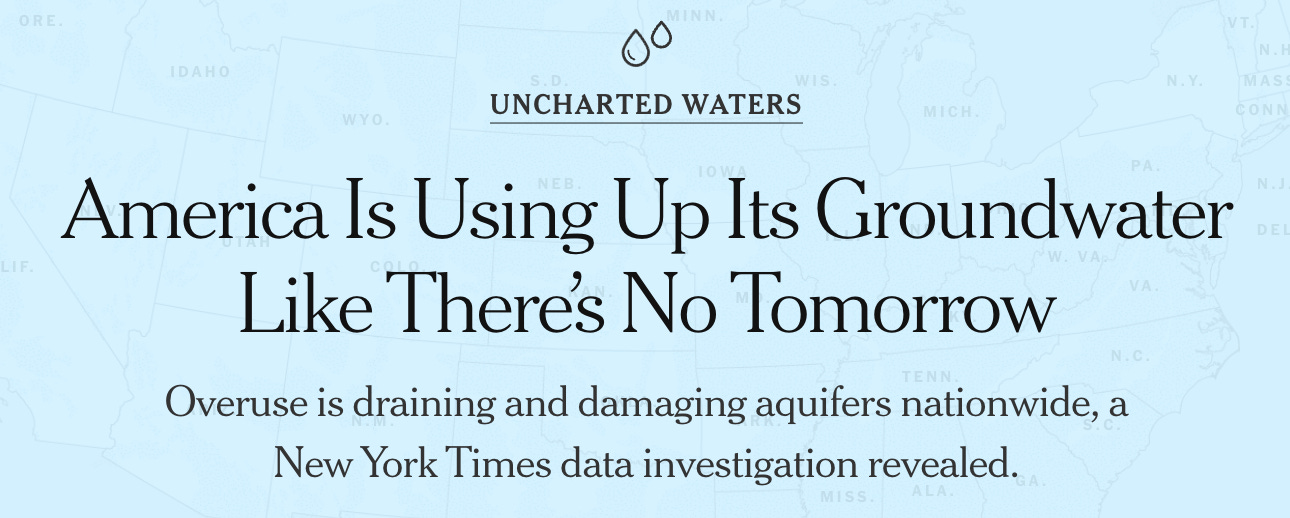The Daily Agenda: Breaking down the city's climate action spending
Big bucks going to transportation and land use ... More money coming next year ... Shipping container border wall is still a drain.
The City of Tucson is set to spend more than $80 million to advance its climate action plan over the next year, which officials say will fund more than 60 different initiatives.
The city broke down how the money would be spent on Monday, explaining how much would go towards each effort and highlighting the top-funded activities.
The efforts are part of the city’s recently adopted climate action plan called Tucson Resilient Together, which addresses five central areas: governance and leadership, community resilience, resource recovery and management, energy, and transportation and land use.
The goal is for the entire city to be “carbon neutral” by 2045 with all city facilities achieving that status by 2030.
The $80 million for this year’s efforts will come from a combination of local, state and federal money, including grants.
The city has allocated the vast majority of the money — $60 million — for transportation and land use. Another $11.6 million will go towards projects that promote community resilience. Energy projects will get $4.9 million, $2.3 million will go towards resource recovery and management, and $1 million will be spent on governance and leadership endeavors.
Our transportation budget is much, much smaller than the city’s, but we still need paid subscribers to help us cover it. Upgrade to paid today, whaddya say?
The city broke down the top 11 funded projects, getting specific with how the money would be spent. It’s no surprise that several of the top-funded projects fall into the transportation and land use category, but there are some well-funded projects planned to promote other goals.
Let’s take a look at the initiatives set to receive the most money over the next year.
Transportation and land use
Nearly $20 million will be dedicated to implementing bicycle, pedestrian and other zero-emission mobility projects. The goal for the $18.8 million activity is to create a transportation network aligned with the Complete Streets approach.
Another $16.4 million will be devoted to promoting “walking, biking and rolling” by creating accessible and attractive street environments.
Just over $12 million will be spent on the creation of a funding and purchase plan for battery electric buses, paratransit vehicles (transportation for people with disabilities) and other zero-emission vehicles used for public transportation services.
Almost $9 million has been allocated to eliminate lanes on wide roads and create public space, walkways, enhanced crossings and signals, and protected bike lanes, meant to increase safety for all road users, especially pedestrians and bicyclists.
Smaller but still well-funded projects include $1.5 million to implement a fleet management plan that mandates zero-emission vehicles and implements efficiency evaluations, ensuring that the city doesn’t own or use more vehicles than it needs
And another $1.4 million to identify options for streetcar, bus rapid transit and local bus access to underserved communities.
Community resilience
The city will spend $3.7 million on the installation and maintenance of shade canopies, shade trees, splash pads, drinking fountains and bottle filling stations in areas where they’re most needed.
$3 million has been set aside to identify community-wide opportunities for nature-based solutions that mitigate flooding, including land or watershed restoration projects.
The Tucson Million Trees Initiative will receive $1.5 million to continue advancing tree equity and water conservation around the city, with a continued focus on native and contextually appropriate trees.
Energy
The city has set aside $1.5 million for the implementation of ongoing weatherization and building tune-ups.
Resource recovery
Closing out the top 11 funded initiatives is the $1.5 million allocated to prioritize food waste reduction through loss prevention, rescue/donation and organic composting.
Supplementing the $80 million in government funds is another $5 million dollars in grant funding that had been identified, but not secured, when the city approved the budget. The addition of the grant dollars brings the total funding for a year’s worth of climate action efforts up to $85 million.
That’s a nice chunk of change, and with this year’s plan set and funding secured, city officials are already looking to the next fiscal year.
The city recently received notice that in addition to $12.1 million it received this year to purchase low- or no-emission public transportation vehicles, another $21.5 million in replacements will be funded next year through the Federal Transit Administration. It will pay for 39 low-emission, carbon-neutral gas buses to replace the city’s remaining diesel buses.
Now that we know which projects are in the works, we’ll be eager to see whether the dollars are spread equitably across town.
Know your customers: Tucson officials should re-work the Sun Tran schedule so it matches the schedules of the people who actually use it, Tucson Sentinel columnist Blake Morlock argues.
“Stop wish casting a ridership Sun Tran doesn't have and will never get aboard,” Morlock writes. “Middle-to-high-income earners aren't getting out of their cars to ride the bus, and yet the system is designed around their schedule. Lower-income service workers are using the system that doesn't always serve their schedule.”
Hold that text: Tucson Unified School District is proposing a policy that would require teachers and all other employees to include a parent, another educator or a supervisor on any electronic or digital communication with students “that could be construed as inappropriate,” the Daily Star reports. This includes, social media, texts and emails. The governing board unanimously voted last week to tentatively approve the policy, but will hear public comment before taking a final vote. The policy can be found on the agenda for the Aug. 22 special meeting. The board is also accepting feedback via email at governingboard@tusd1.org.
Checking the voter rolls: The state treasurer is sending nearly $1 million to the Pima County Recorder’s Office to review the accuracy of the voting rolls, County Administrator Jan Lesher wrote in an Aug. 28 memo to the Board of Supervisors. The money comes from a 2022 law that set aside $6 million for Arizona’s larger counties.
We wish lawmakers would set $6 million aside for local news startups. Instead, we’ll have to hit 50,000 paid subscribers to get there.
Not just Arizona: The whole country is draining their groundwater reserves, the New York Times reports. The paper analyzed water levels at tens of thousands of sites and found four out of every 10 sites hit record lows in the past decade. The Southwest obviously has water problems, but so does much of the Great Plains region.
Good riddance: The chair of the San Carlos Place Neighborhood Association, Peter Williams, came up with an easy way to get rid of the racist policies embedded in property restrictions across Tucson’s subdivisions, the Star’s Henry Brean reports.
“On July 11, with the blessing of the rest of the association’s board, he simply submitted a revised version of the neighborhood’s codes, along with a notarized letter explaining the change and his authority to make it,” Brean wrote. “A black rectangle now covers the section of the San Carlos CC&Rs that once prohibited ‘any person of African or Asiatic descent’ or ‘not of the White or Caucasian race’ from owning property or living in the subdivision unless they were employed there as domestic servants.”
Good money after bad: The shipping container barrier former Gov. Doug Ducey put in place at the Arizona-Mexico border last year continues to be a financial burden on taxpayers, Capitol Media Services’ Howard Fischer reports. The state spent more than $160 million to build it and then tear it down. Now, federal officials say they will drop the lawsuit they filed against the state as long as Arizona puts up $2.1 million so the U.S. Forest Service can fix the environmental damage.
2,480: The metric tons of carbon dioxide emissions that will be reduced after the City of Tucson swaps out its remaining 39 diesel buses to those that run on carbon neutral gas.













The ADU design should include shade.
Awesome to see a bunch of relatively ambitious plans! I hope they turn into some durable change!